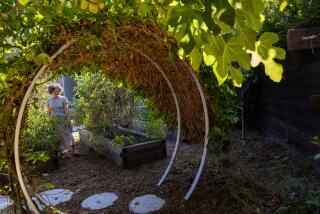Time to Plant Vegetable Perennials : Artichokes, Asparagus, Rhubarb Flourish in Southland
- Share via
It seems like asking too much of a vegetable for it to look good as well as taste good, and for it to come back year after year without much attention. Yet there are three perennial vegetables--artichokes, asparagus and rhubarb--that will do just that, and now is the time to plant them.
The bold and showy artichoke plant does best in the foggy areas of central California but it will also grow in the milder parts of Southern California. Once established, this beautiful gray-green plant will produce for five or more years. A member of the thistle family, it grows four feet tall and spreads from four to six feet. The edible part is a large flower bud, and it must be harvested while still immature. If it ripens, it becomes a showy purple flower.
There’s only one artichoke variety available in nurseries, Green Globe. You may plant a root division, a bedding plant or seeds; all should be available now in nurseries. Give them a sunny location, though in hot areas they should have half-day shade. Set root divisions so the buds or shoots are just above the soil line, and space the plants four to six feet apart. Water well once weekly after growth starts, and sprinkle the plants on very hot days. Fertilize twice a year, spring and fall. If you plant seeds, start them indoors in peat pots. In most areas you’ll get only one crop yearly, in the spring.
Harvest the buds when about four inches in diameter and still tightly closed. Be sure to leave two inches on each stalk. Four to six plants are plenty for one family.
A Decorative Choice
Where the artichoke plant is bold and dramatic, the asparagus plant is ferny and decorative. It looks good and does well in a sunny, narrow strip in front of a fence or wall, where it can produce for 20 years.
Resist the temptation to harvest asparagus the first year after planting, it takes a year for the roots to become firmly established. You can buy year-old roots from a nursery or you can plant seed, though that takes an additional year to grow. Mary Washington is a good variety, and 40 roots will be more than enough for a family.
These roots could be planted in two rows, each 20 feet long and three feet apart. Dig trenches a foot wide and 10 inches deep, put four inches of aged manure or compost on the bottom, soak thoroughly and then lay the roots in about a foot apart with crowns up. Cover with only two inches of soil and tamp firmly. As the shoots appear, rake in more soil but never cover the tips. Do this about once a month until the trenches are filled.
Water well once weekly. Let the plants grow until early winter when the foliage turns brown. Then cut them back to ground level. In early spring when the first shoots appear, add a side-dressing of a vegetable fertilizer and water thoroughly. In March of the second year you can harvest your first crop, but only for a month. In the third year you can harvest for two months, cutting the spears at ground level when five to eight inches long.
A Foliage Plant
Rhubarb is a good-looking foliage plant, but don’t eat those rich green leaves; they’re poisonous. It’s the ruby-red stems that make the delicious sauce and pies. Rhubarb is best grown from roots or divisions but may also be grown from seed, though that takes a year longer. You should not harvest anything the first year after planting.
A week before planting, add generous amounts of well-rotted manure to soil and mix in a time-release fertilizer for each plant. Put the roots three inches deep and four feet apart, then water thoroughly. Side-dress with a vegetable fertilizer when plants are about a foot tall and repeat in the fall. Water about every 10 days but withhold water for several weeks in mid-summer to force plants into dormancy--this improves the flavor. Plants get too large after four or five years, so divide and replant them. When harvesting a crop, break the stalks off at the base.






